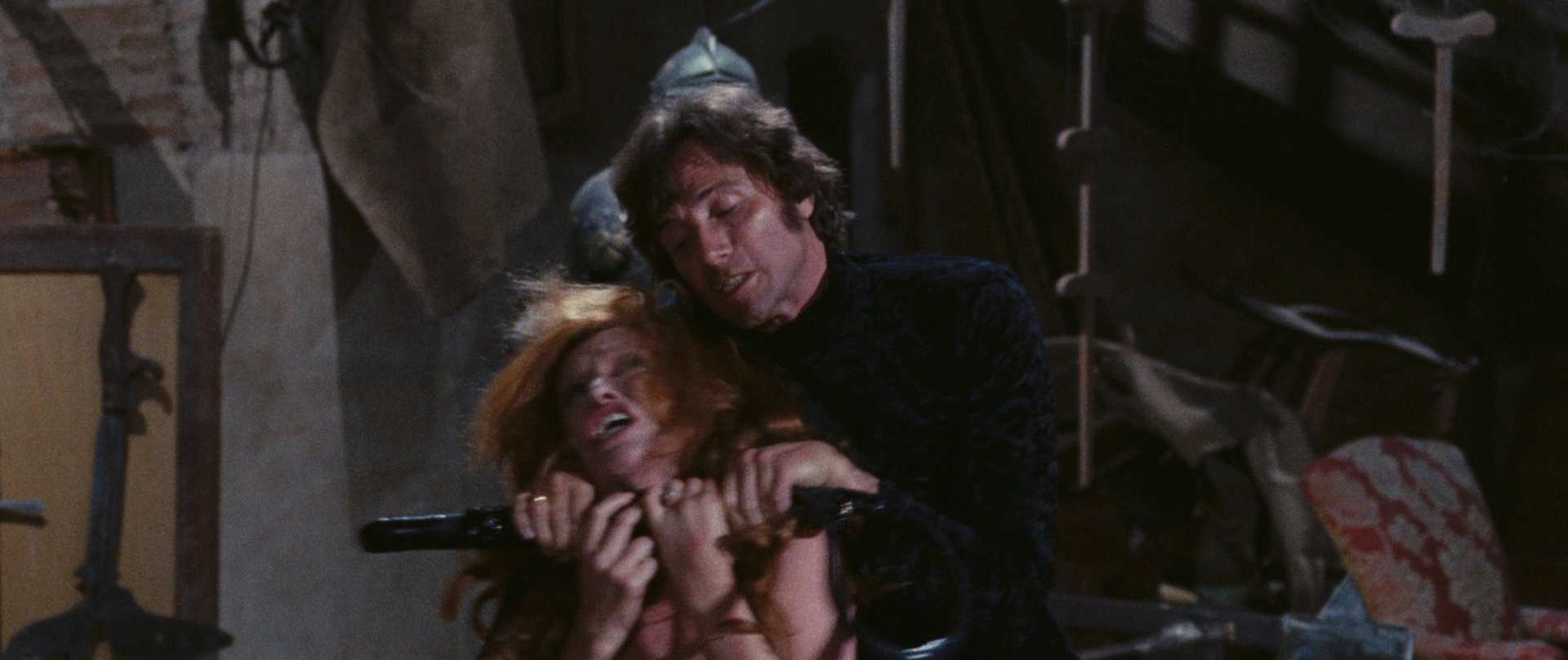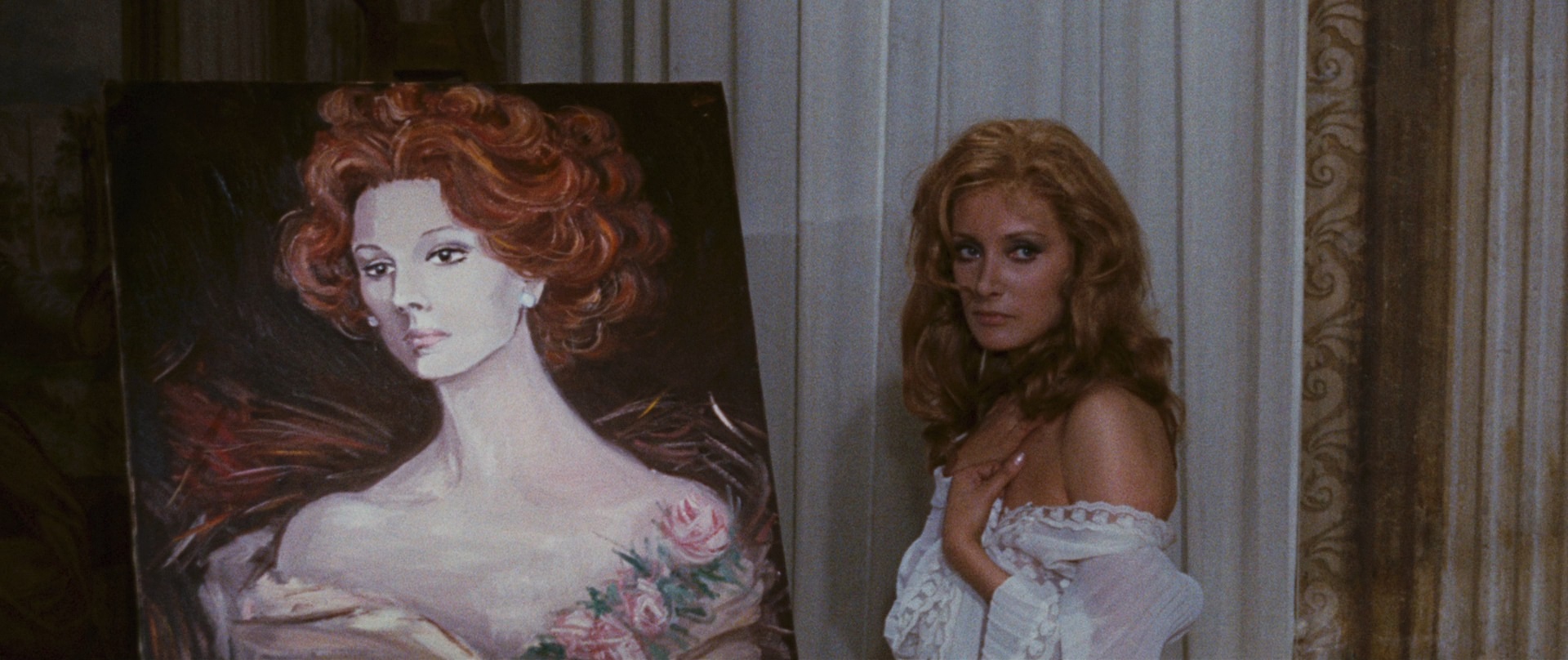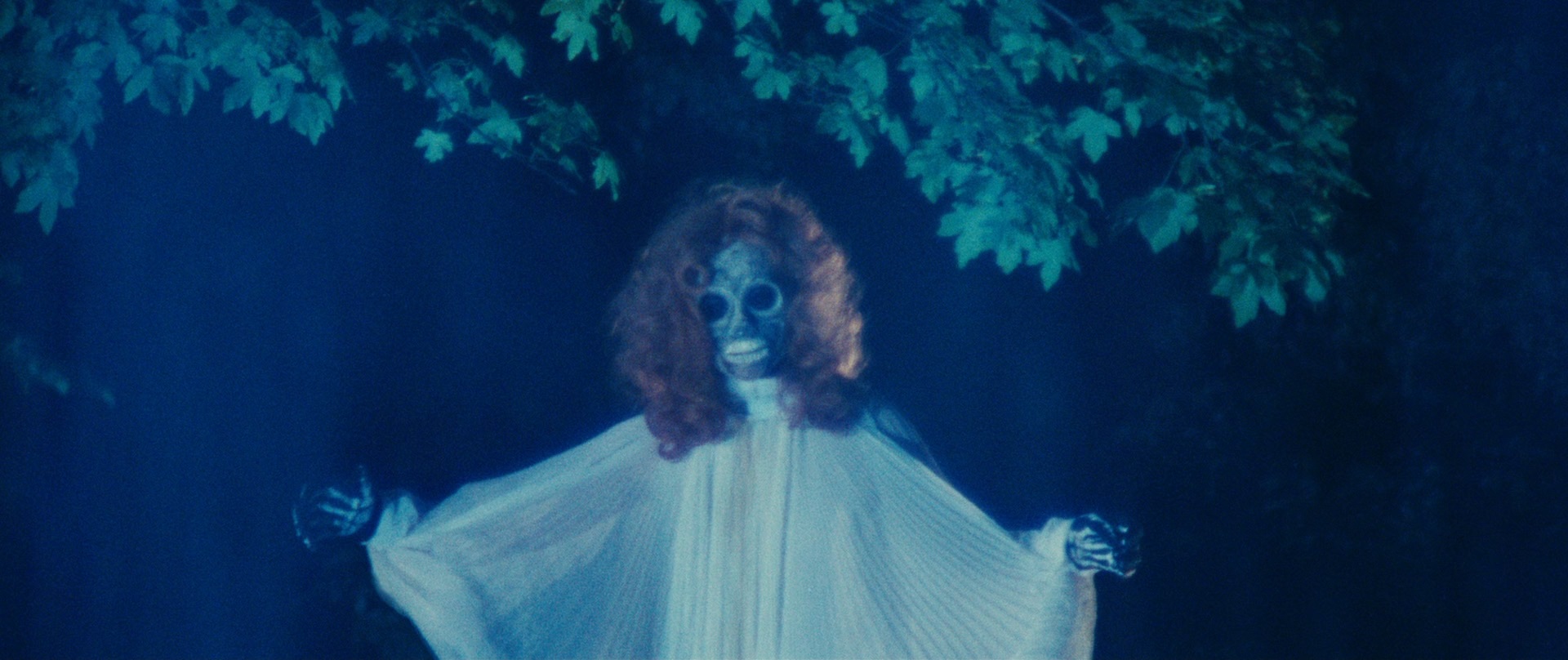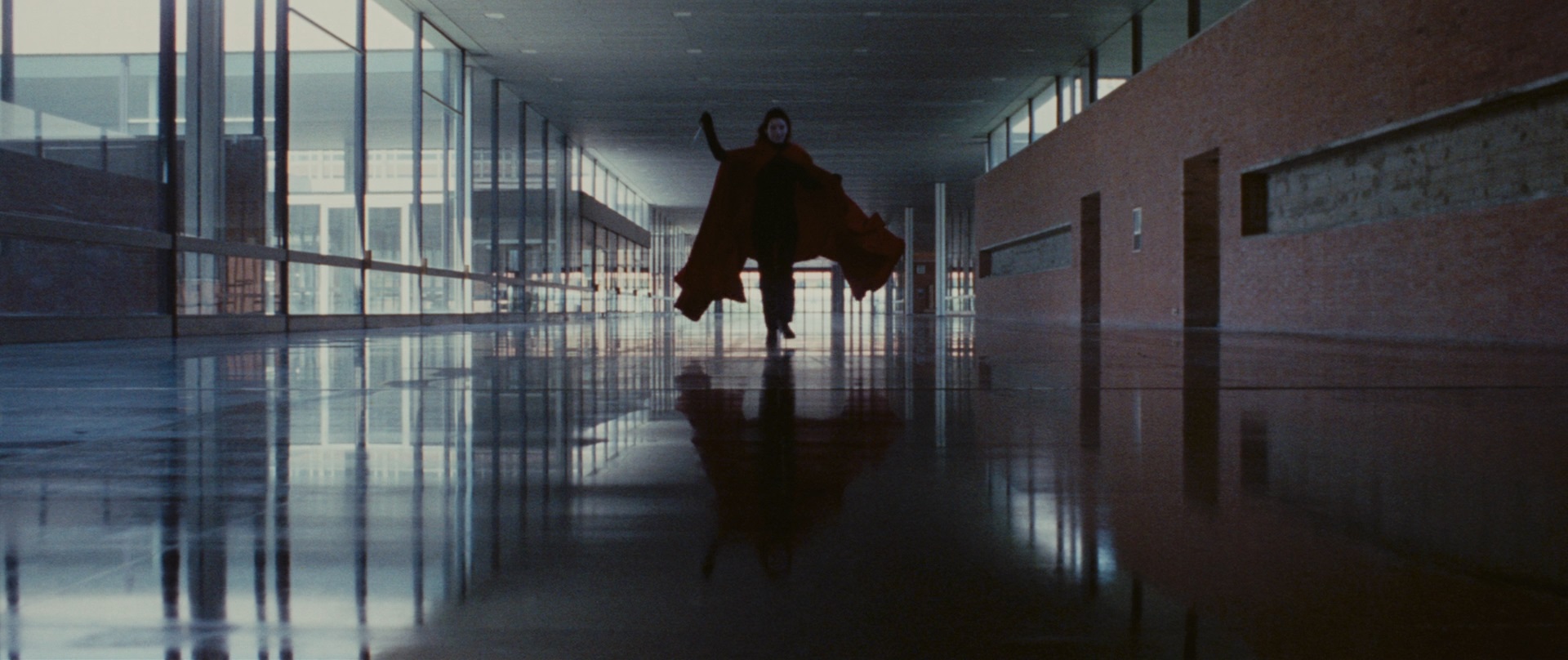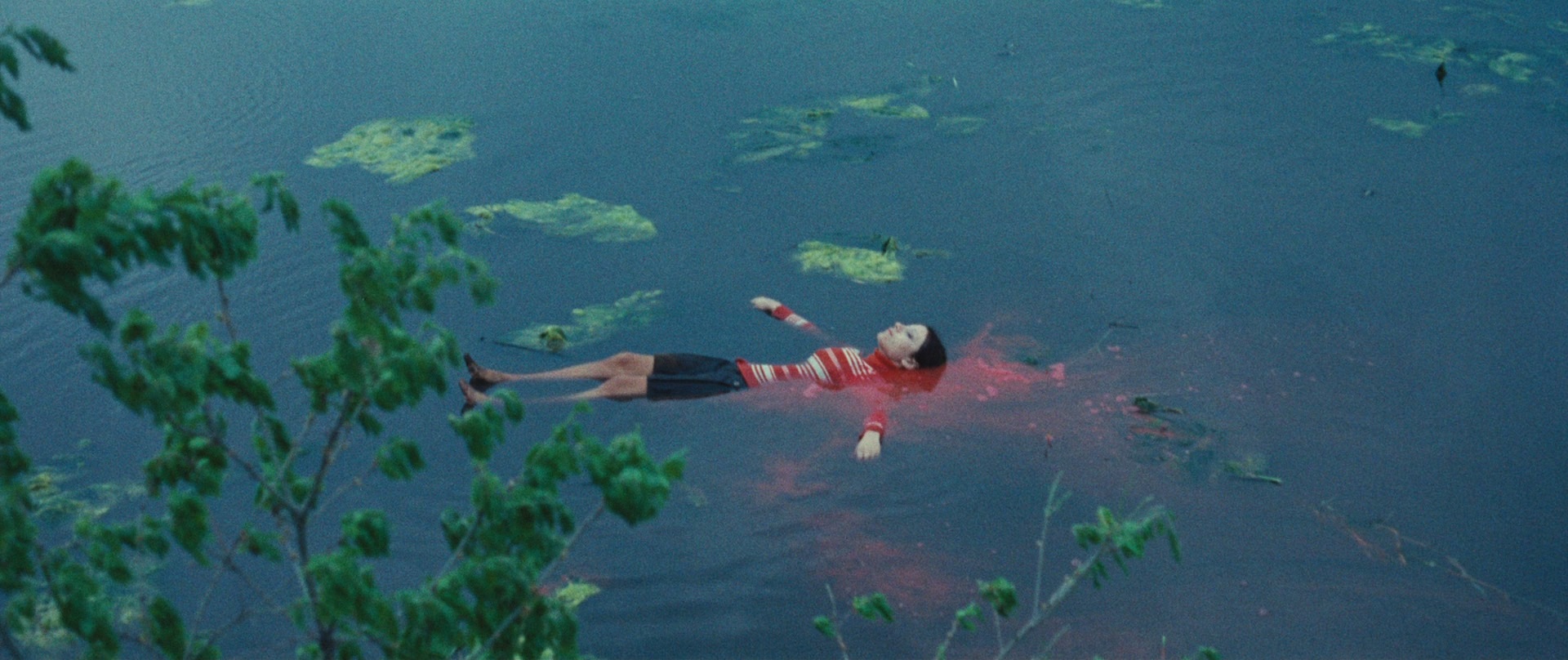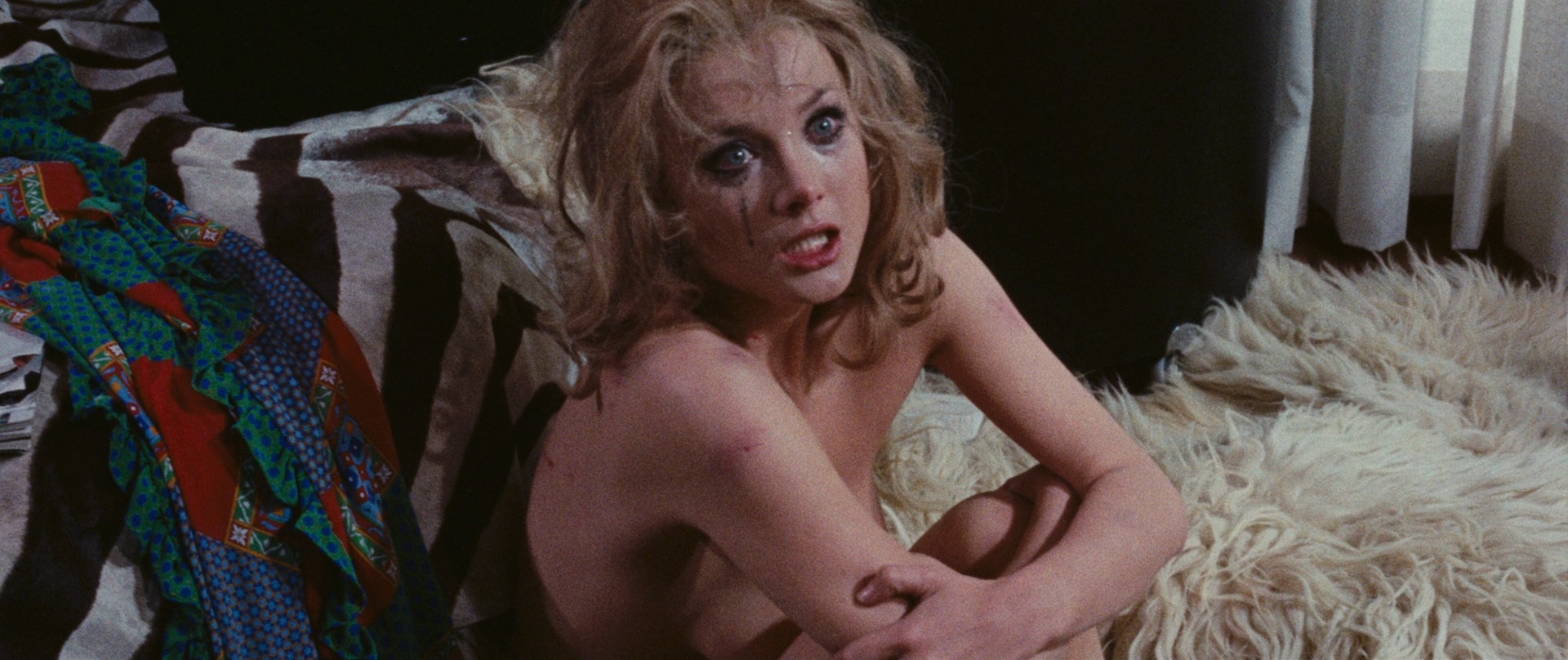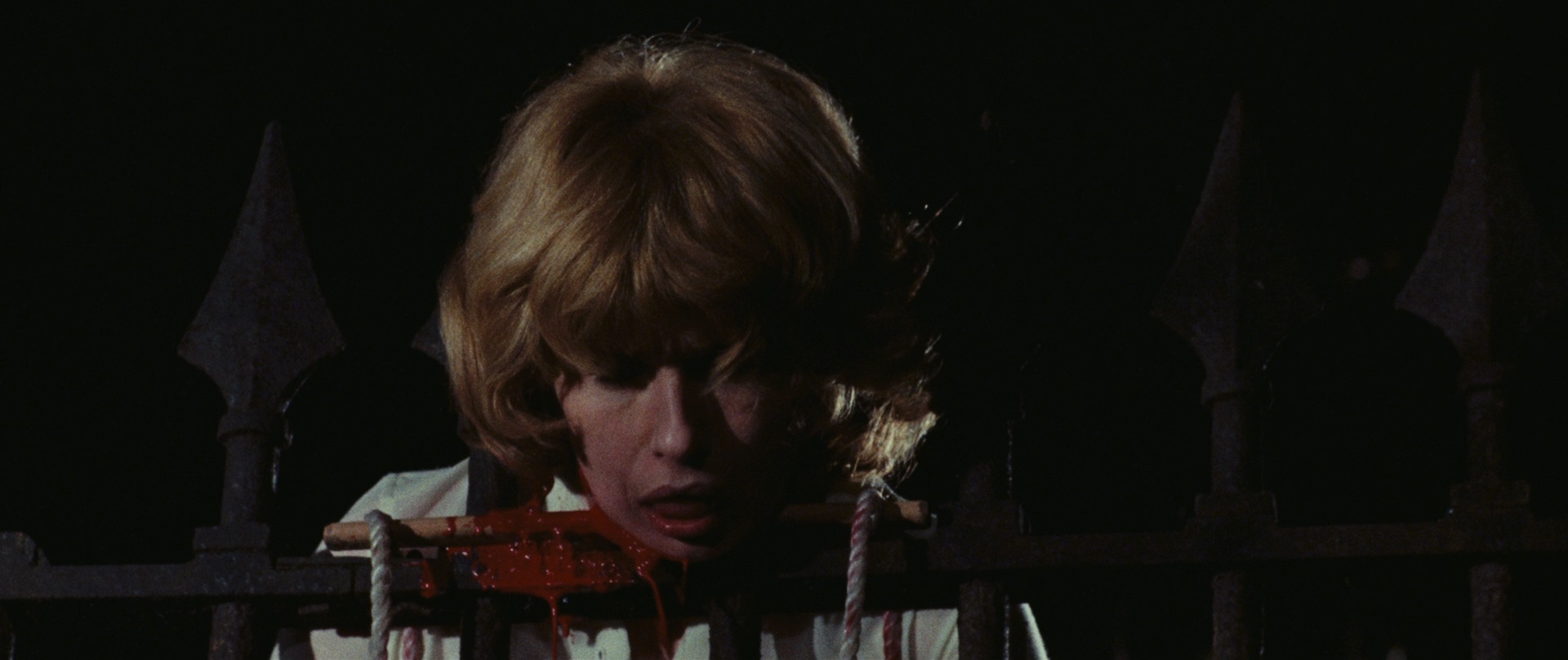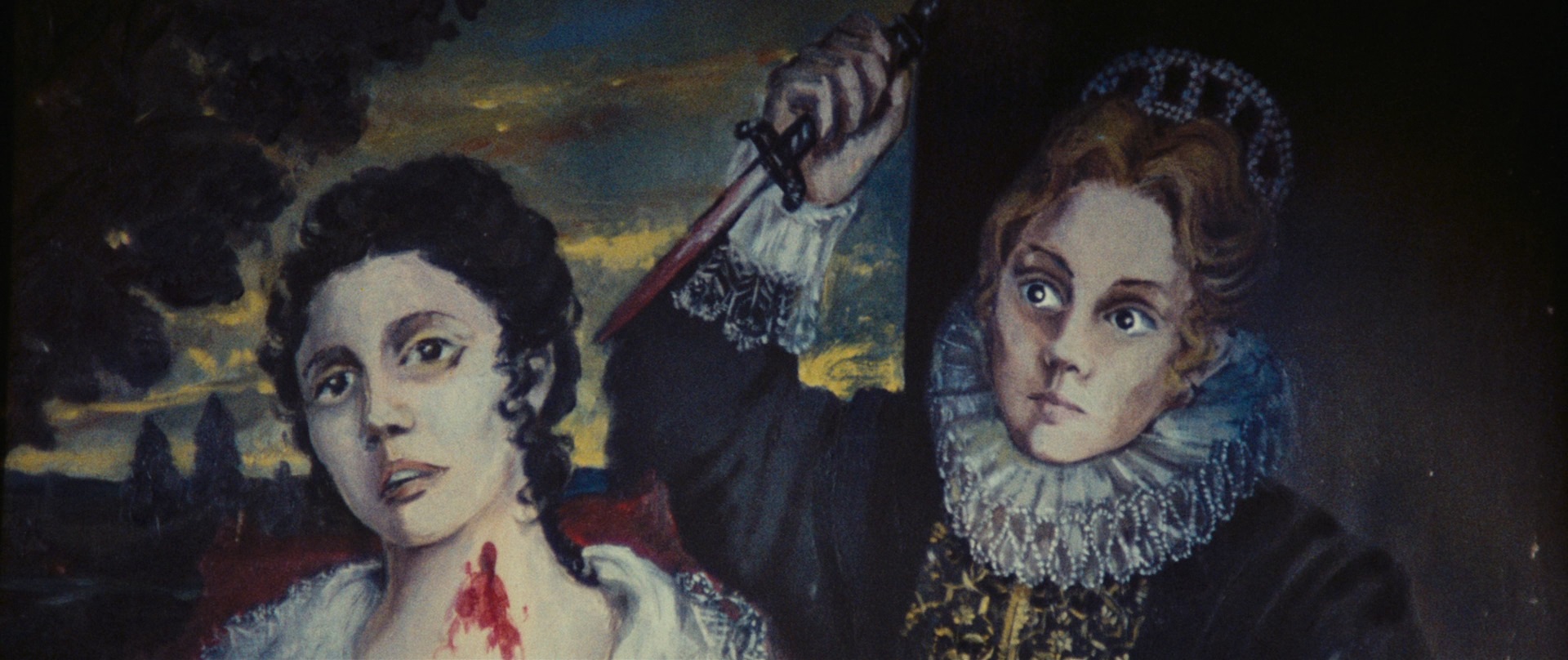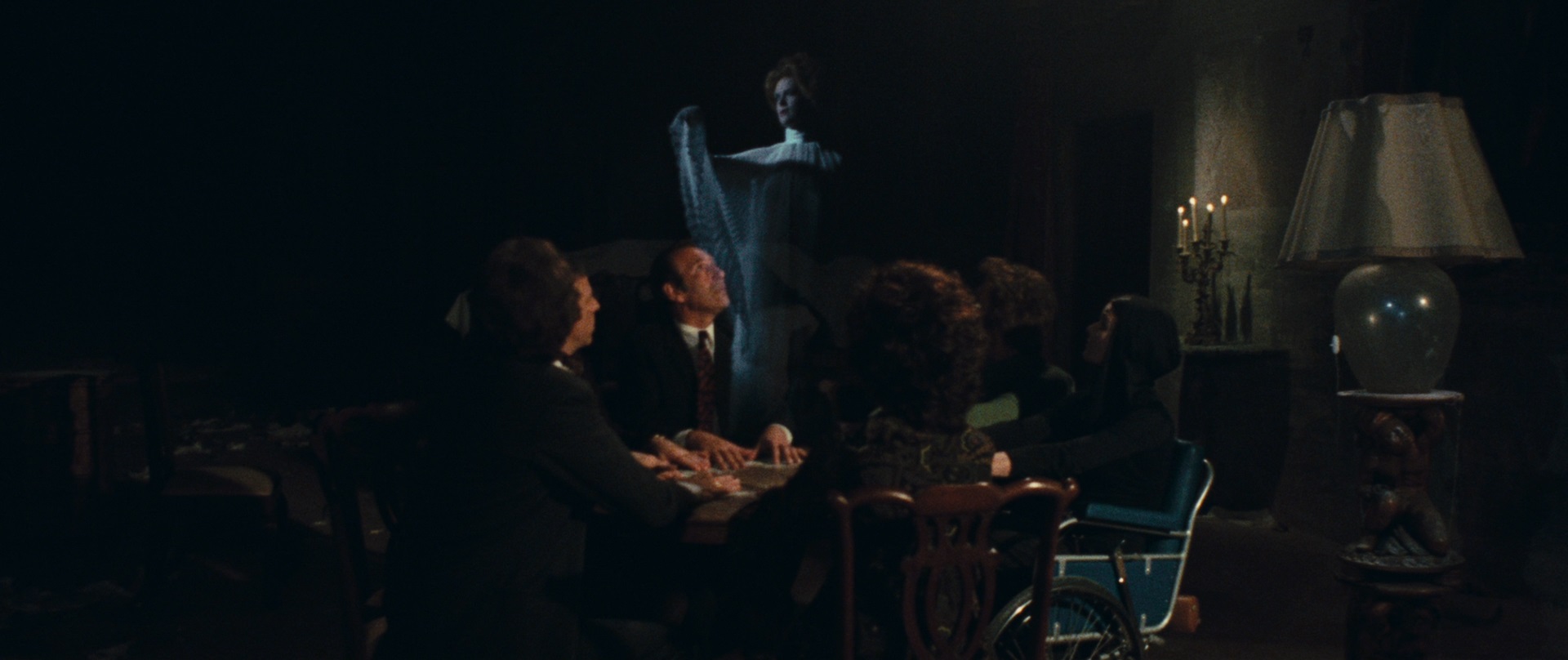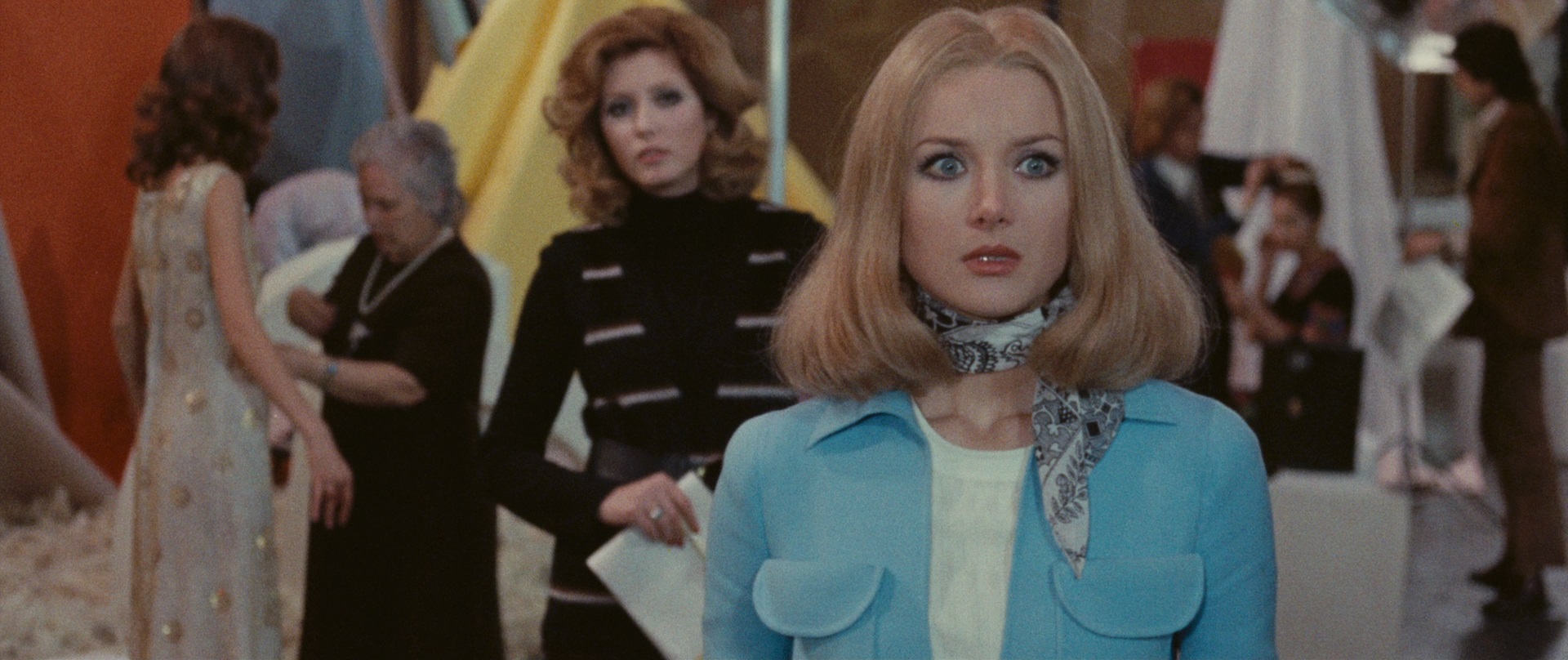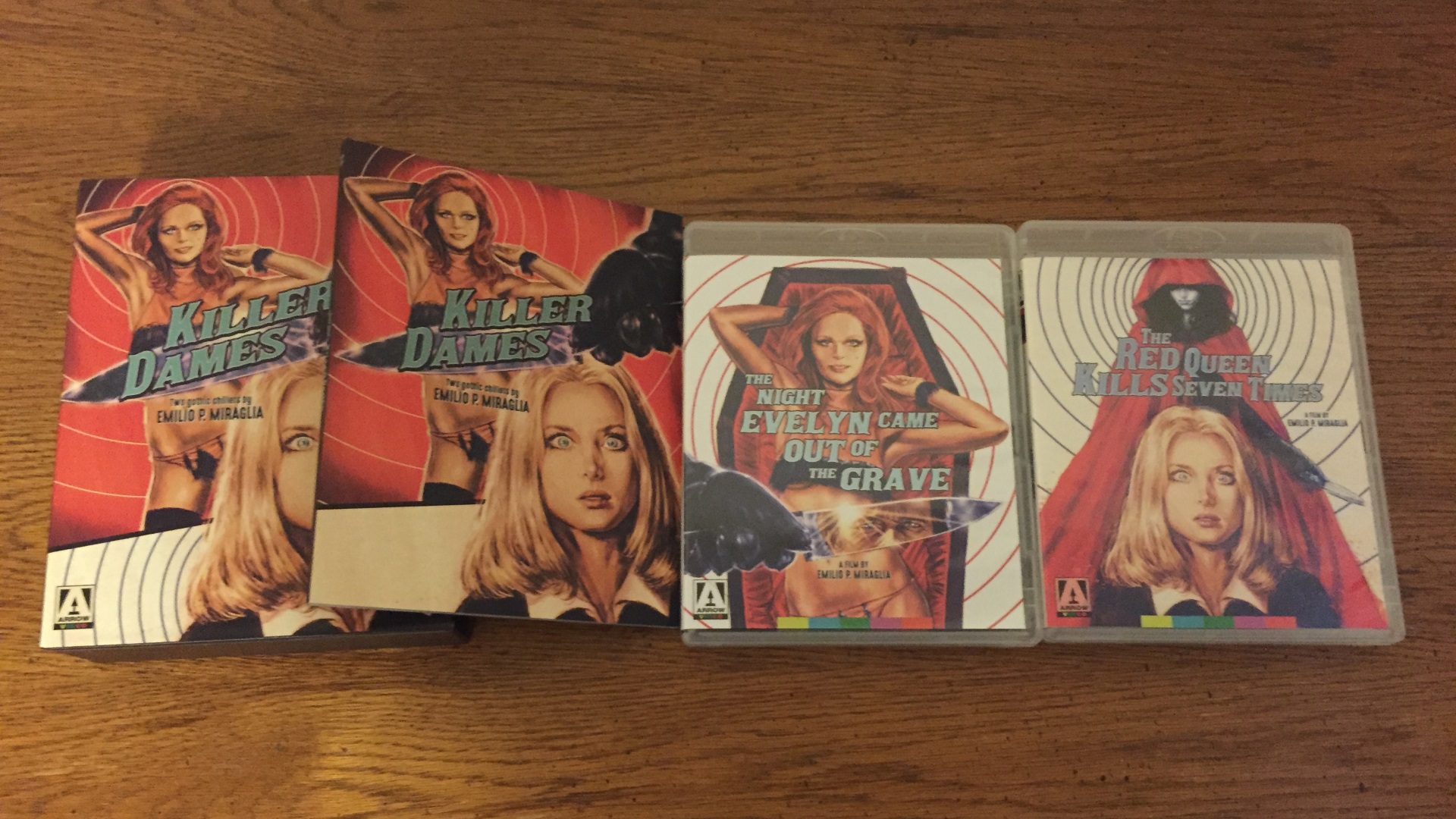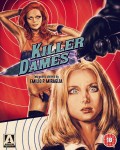| Reviews & Columns |
|
Reviews DVD TV on DVD Blu-ray 4K UHD International DVDs In Theaters Reviews by Studio Video Games Features Collector Series DVDs Easter Egg Database Interviews DVD Talk Radio Feature Articles Columns Anime Talk DVD Savant Horror DVDs The M.O.D. Squad Art House HD Talk Silent DVD
|
DVD Talk Forum |
|
|
| Resources |
|
DVD Price Search Customer Service #'s RCE Info Links |
|
Columns
|
|
|
Killer Dames: Two Gothic Chillers by Emilio P. Miraglia
Arrow Video // R // May 24, 2016 // Region 0
List Price: $69.95 [Buy now and save at Amazon]
Arrow Video isn't the first label to pair together Emilio Miraglia's two gothic gialli -- The Night Evelyn Came Out of the Grave and The Red Queen Kills Seven Times -- but with a release this definitive, they just might be the last.
The Night Evelyn Came Out of the Grave (1971)
Although The Night Evelyn Came Out of the Grave is generally classified as a giallo, it owes as much to Roger Corman's Poe adaptations as it does to, say, Argento's seminal The Bird with the Crystal Plumage. Despite taking place in the then-present day, the film's imagery is decidedly gothic, set predominantly against the backdrop of a castle half-crumbled into ruin and a nearby crypt. A full hour passes before the first glimpse of an otherwise unseen killer's gloved hands. That's not to say that the body count hovers around zero prior to that point, though referring to them as "murders" may be a bit presumptuous. It's all but spelled out that the deeply troubled Lord Alan Cunningham (Anthony Steffen) has been routinely slaughtering the strippers and prostitutes he lures into his gothic dungeon, although their beaten, branded corpses are never seen.
Then again, Lord Cunningham ensures that we only see what he wants us to. This depraved routine is one he long ago had honed to perfection. The fake license plates on his car are quickly disposed of, tossed aside with a convenient excuse before ever approaching his familial castle. The extravagant sums offered to his prey by this well-mannered gentleman lowers their guard, and even when they first step foot into what is unmistakeably a torture chamber, they shrug it off as the playthings of another rich kink. The whipping becomes less and less playful, he pulls the braided leather handle tightly against their throats, and...well, when next we see Lord Cunningham, it's easy enough to fill in the blanks.
His dark proclivities are no secret to the Lord's close friends and family, though they're less concerned about the women he's tormented and presumably murdered so much as the fragility of his mind. Stop bringing this parade of disposable redheads to your ancestral home; they'll only bring memories of your long-dead wife bubbling to the surface. Remarry. Move forward. Lord Cunningham has the castle restored to its former glory, and as for remarrying...well, why wait? He proposes to a gorgeous young woman (Marina Malfatti) just a couple of hours after meeting her at a party, and, coiling her naked body around him that much more tightly, Gladys eagerly accepts.
A seamless transition it's not. Lord Cunningham remains wholly obsessed with a painted portrait of his dead wife. Despite great care being taken to staff the sprawling estate with blonde maids to ease her husband's ravaged mind, Gladys is certain she's spotted a redhead among the lot late one night. Was someone dolled up as a maid to more easily swipe a set of expensive silverware, or is it a deliberate attempt at unnerving Lord Cunningham? One by one, those closest to him meet with indescribably gruesome ends. Did Evelyn survive, using her death as cover to exact her revenge? Did she truly die and find some way to claw her way back into the realm of the living?
The Night Evelyn Came Out of the Grave is remarkably daring. I love the way it blends traditional gothic imagery with the sex, violence, and betrayals that are such mainstays of the giallo. It's a hell of a risk to place someone as wholly unsympathetic as Lord Cunningham in the lead role: cold and calculating when luring in his prey yet completely unhinged when a fly is ensnared in his web. A scheming character with that sort of bloodlust would be the villain in most any other movie, and here, he's the hero...or as close as the film gets to one, at least. The way in which it weaves the undeniably supernatural -- a spectral apparition during a séance -- into the premise shatters certain expectations, blending in deftly with the gothic backdrop. Admittedly, quite a lot of time bridges the last of Cunningham's sadistic preying with the spate of murders that follow. Still, the lingering questions revolving around Evelyn's life and death maintain an air of mystery, and the inventiveness of those eventual kills -- each in some way involving animals -- prove to be worth the wait. Erika Blanc isn't in The Night Evelyn Came Out of the Grave for long, but she's easily the most memorable thing about it: introduced go-go dancing her way out of a coffin, perching me on the edge of my seat when she realizes what Lord Cunningham has in store for her, and fleeing for her life in the proudest stalk-and-slash tradition. Marina Malfatti doesn't leave quite as much of an impression, but the barely-there lingerie she's clad in for much of the film (when she's wearing anything at all) sure does come close.
Some of those gambles pay off handsomely, and others...well... It's bizarre that the doctor (Giacomo Rossi Stuart) who cared for Lord Cunningham when he was institutionalized seems to know full well about his string of murders (or, well, just life-altering torture if you're feeling generous), and yet he passively repeats that his former patient just needs to get his head screwed on straight. What cure does the good doctor suggest to quell those misogynistic, sadomasochistic, seemingly murderous urges? Marriage! He's not wrong, though; after Lord Cunningham and Gladys are wed, that blinding sadism completely fades away. Much of the tension is sapped away when a psychopath no longer appears to be on the precipice, nor is Lord Cunningham ever forced to answer for his crimes. It doesn't help matters that Anthony Steffen is far from a compelling lead either. There are so many other odd things about Lord Cunningham's family, from his twentysomething year old invalid aunt (who, inexplicably, gets up out of her wheelchair with no trouble when investigating a suspicious sound) to the enormous hoop earring and hyperflamboyant ensemble his way-hetero cousin (Enzo Tarascio) is rocking at one point. Much of what unfolds is implausible and needlessly convoluted, not that that's terribly out of step from any other giallo film, and the twists-upon-twists-upon-twists in its final moments are too much of a blast for me to grouse or groan about anything, really.
Those aching for an unnervingly intense, visually stylish giallo will likely walk away disappointed with The Night Evelyn Came Out of the Grave, and it doesn't exactly live up to the iconic poster art that entranced me years ago. At the same time, it's so wonderfully strange and over-the-top -- from a funereal striptease to gut-gobbling foxes -- that I can't help but love it anyway. You may not be impressed, but you'll never be bored either. Plus, y'know, multiple redheads completely naked aside from a pair of thigh-high boots.
The Red Queen Kills Seven Times (1972)
When The Night Evelyn Came Out of the Grave proved to be a hit, Emilio Miraglia and company figured they might as well see if lightning could strike twice. Many of the same elements do indeed find their way into Miraglia's second stab at gothic giallo: another castle and another mental institution in another international setting, quite literally dreamlike imagery, flirtations with the supernatural, the siren song of an inheritance, a sleazy extortionist indistinguishable from the one in The Night Evelyn Came Out of the Grave, another painting that evokes a murderous rage, a similarly storied family pursuing their own motives, a lead with bloodstained hands before the meat of the film is underway, and -- why not? -- Marina Malfatti in her trademark everything-but-the-nipple lingerie. The spectre looming over Wildenbrücks is even named Eveline, looming over a spate of grisly murders from the afterlife. As much as these two films share in common, The Red Queen Kills Seven Times hardly settles for more of the same. Where the balance between the gothic and the giallo leaned far more heavily in favor of the former throughout The Night Evelyn Came Out of the Grave, The Red Queen Kills Seven Times shifts its weight in the opposite direction.
As lovely as this castle in the German countryside may appear from a distance, it's plagued by a terrible curse. Centuries ago, it was the home of two endlessly quarreling sisters: the Red Queen and Black Queen. Despite their noble background, the two of them had fought like feral animals since they were children, and that revulsion burned brightly even into adulthood. Their fighting inevitably spiraled out of control, and the Red Queen lay dead at the hands of her sister, slain in her sleep. It doesn't take. Months later, the Red Queen roared back into this mortal coil to butcher six victims in rapid succession. Her reign of terror ended with the murder of the Black Queen, after which point the Red Queen's thirst for vengeance had been slaked and she once again returned to the grave. The cycle begins anew once every century, afflicting whatever pair of sisters are unfortunate enough to call this castle home.
Just another tall tale from Grandpa (Rudolf Schündler), right? If two sisters were ever plagued by a murderous curse, it'd be Kitty and Eveline. We first meet them as children, with the raven-haired Eveline swiping and savagely stabbing Kitty's baby doll till its head caved in, cackling all the while. The chases and catfights never really cease throughout the next couple of decades, at least not until Eveline ships off for a fresh start in the United States. That's the story Kitty (now played by Barbara Bouchet) tells anyone who asks, anyway. As for what really happened...?
As sweet and innocent as Kitty seemed as a child, it would seem that she is, in fact, the Black Queen. Though she doesn't pay her grandfather's tales of an ancient curse any mind, the Red Queen returns just the same. Kitty's family...her co-workers at a prestigious fashion house...her friends soon fall. The body count grows higher and higher until the time comes for the Black Queen and Red Queen to reunite once again.
The Red Queen Kills Seven Times is almost exactly what I hoped it'd be. It benefits from a tighter focus and more nimble pace than The Night Evelyn Came Out of the Grave. Those let down by ...Evelyn...'s relatively low body count need only look at the title of this follow-up. There are more than seven murders, by the way. Alberto Spagnoli's cinematography is far more stylish and memorable than anything in ...Evelyn..., reveling in this film's more cosmopolitan backdrop and vivid, high fashion palette. Barbara Bouchet remains one of the most impossibly gorgeous women to ever walk the earth, and although she's not exactly pure as the driven snow, she's a considerably more sympathetic lead than Lord Cunningham. ...and this is unmistakeably a giallo, with the operatic murders, ample nudity (including, hey! Sybil Danning), and bottles of J&B scotch that the genre demands. The Red Queen in her flowing red cape makes for a hell of a slasher, and her gleeful cackle after each attack sets her apart from the mute / hissing murderers of most gialli. Some of the violence remains shocking even after more than forty years, its key twists are more effective than those in ...Evelyn..., and The Red Queen Kills Seven Times uses its labyrinthine plotting to greater success.
Sure, there is a completely gratuitous rape scene with no bearing on anything that happens in the film afterwards, and Ugo Pagliai is woefully miscast as the dull-as-dishwater male lead. I mean, if you can make it through multiple paragraphs of plot summary without ever needing to bring up the film's most critical male character, something got botched along the way. Still, The Red Queen Kills Seven Times is exceptionally stylish, well-acted, overflowing with beautiful women (Pia Giancaro in particular is...whew), and generally everything I hoped it'd be and then some. I wouldn't point to it as a high water mark for the genre, but sometimes it's a nice change of pace to swap out that black leather in favor of a lady's evening gloves.
Video / Audio
Arrow Video has always played fair between Italian and English in their giallo releases, but Killer Dames takes it one step further. Thanks to the miracle of seamless branching, the opening sequences and closing credits of these two films can be viewed in either language.
The Night Evelyn Came Out of the Grave and The Red Queen Kills Seven Times feature 24-bit, uncompressed, monaural soundtracks in both of these languages as well. The subtitles are proper translations rather than mere transcriptions of the English dubs, and the differences between the two can be stark. Although either language is an equally viable choice, seeing as how all of the audio you're hearing was recorded in post-production anyway, I found myself preferring the Italian tracks. Part of it's the allure of something more exotic, part of it's because I'm more sensitive to lousy acting in English, and part of it's just because the Italian tracks sound better to my ears. At least in the portions I compared, the English track in The Night Evelyn Came Out of the Grave runs hot, while the one in The Red Queen Kills Seven Times is lower and duller than its Italian counterpart. (I do prefer the voice of young Kitty in English, though.) The Italian tracks don't exactly belie their age but leave very little room for complaint, free of any clipping, dropouts, intrusive background noise, or any other flaw of note. The Night Evelyn Came Out of the Grave is the better sounding of the two, with The Red Queen Kills Seven Times striking me as being a bit on the harsh side, but I'm still thrilled with what Arrow has delivered for both halves of this double feature.
The visual presentations are, as ever, world-class. Both films boast striking palettes, from the pastoral greens in Lord Cunningham's dreamlike reflections of his wife to the searing crimsons throughout The Red Queen Kills Seven Times. The latter film is given more of an opportunity to show off these colors, while The Night Evelyn Came Out of the Grave prefers to revel in its gothic imagery during the dead of night. The photography in ...Evelyn... doesn't excel under limited light, and its day-for-night sequences aren't particularly convincing. Despite some sporadic softness, I remain in awe of how well-defined and filmic these two presentations are, and they are both absolutely immaculate. Extraordinary, but it's not as if you'd expect anything less from Arrow Video.
Extras
Along with the decade-old interviews from NoShame's DVD special editions, The Night Evelyn Came Out of the Grave and The Red Queen Kills Seven Times both feature a slew of newly-produced extras.
Of particular note is the sixty page booklet that's exclusive to this limited edition set. James Blackford delves into how The Night Evelyn Came Out of the Grave both embraces and defies the conventions of the giallo, drawing parallels to a great many films spanning all manners of genre. Blackford's essay is wonderfully thorough, to the point that it'd appeal to those who haven't yet seen the film. As Kat Ellinger explores the second half of this double feature, she takes particular delight in The Red Queen Kills Seven Times' clashing imagery and themes: the light versus the dark, the modern pitted against the gothic, etc. Costume and production designer Lorenzo Baraldi is the focal point of a number of this collection's extras, and he also proves to be central to Rachael Nisbet's essay. It's a detailed, compelling analysis of how costumes and color drive these two astonishingly stylish films. Finally, Leonard Jacobs writes contributes a terrific piece -- the most polished and scholarly in this booklet -- about how gialli deftly blended together elements culled from so many other genres. Jacobs casts a net much wider than these two films of Miraglia's, although they are understandably lavished with the most attention. He also makes me want to write "Fashion-House Giallo" over and over and over. All four of these essays are well worth reading and outclass any analysis I have to offer.
The Final Word
Neither The Night Evelyn Came Out of the Grave nor The Red Queen Kills Seven Times rank as top-shelf thrillers, but these gothic gialli are so distinctive and just a hell of a lot of fun that they'd have come enthusiastically recommended no matter what the release. That Arrow Video has lavished them with such attention and this many hours of extras...? It's well worth setting aside fifty bucks and the better part of a weekend to spend with these Killer Dames. Highly Recommended.
The Night Evelyn Came Out of the Grave (1971)
Although The Night Evelyn Came Out of the Grave is generally classified as a giallo, it owes as much to Roger Corman's Poe adaptations as it does to, say, Argento's seminal The Bird with the Crystal Plumage. Despite taking place in the then-present day, the film's imagery is decidedly gothic, set predominantly against the backdrop of a castle half-crumbled into ruin and a nearby crypt. A full hour passes before the first glimpse of an otherwise unseen killer's gloved hands. That's not to say that the body count hovers around zero prior to that point, though referring to them as "murders" may be a bit presumptuous. It's all but spelled out that the deeply troubled Lord Alan Cunningham (Anthony Steffen) has been routinely slaughtering the strippers and prostitutes he lures into his gothic dungeon, although their beaten, branded corpses are never seen.
Then again, Lord Cunningham ensures that we only see what he wants us to. This depraved routine is one he long ago had honed to perfection. The fake license plates on his car are quickly disposed of, tossed aside with a convenient excuse before ever approaching his familial castle. The extravagant sums offered to his prey by this well-mannered gentleman lowers their guard, and even when they first step foot into what is unmistakeably a torture chamber, they shrug it off as the playthings of another rich kink. The whipping becomes less and less playful, he pulls the braided leather handle tightly against their throats, and...well, when next we see Lord Cunningham, it's easy enough to fill in the blanks.
His dark proclivities are no secret to the Lord's close friends and family, though they're less concerned about the women he's tormented and presumably murdered so much as the fragility of his mind. Stop bringing this parade of disposable redheads to your ancestral home; they'll only bring memories of your long-dead wife bubbling to the surface. Remarry. Move forward. Lord Cunningham has the castle restored to its former glory, and as for remarrying...well, why wait? He proposes to a gorgeous young woman (Marina Malfatti) just a couple of hours after meeting her at a party, and, coiling her naked body around him that much more tightly, Gladys eagerly accepts.
A seamless transition it's not. Lord Cunningham remains wholly obsessed with a painted portrait of his dead wife. Despite great care being taken to staff the sprawling estate with blonde maids to ease her husband's ravaged mind, Gladys is certain she's spotted a redhead among the lot late one night. Was someone dolled up as a maid to more easily swipe a set of expensive silverware, or is it a deliberate attempt at unnerving Lord Cunningham? One by one, those closest to him meet with indescribably gruesome ends. Did Evelyn survive, using her death as cover to exact her revenge? Did she truly die and find some way to claw her way back into the realm of the living?
The Night Evelyn Came Out of the Grave is remarkably daring. I love the way it blends traditional gothic imagery with the sex, violence, and betrayals that are such mainstays of the giallo. It's a hell of a risk to place someone as wholly unsympathetic as Lord Cunningham in the lead role: cold and calculating when luring in his prey yet completely unhinged when a fly is ensnared in his web. A scheming character with that sort of bloodlust would be the villain in most any other movie, and here, he's the hero...or as close as the film gets to one, at least. The way in which it weaves the undeniably supernatural -- a spectral apparition during a séance -- into the premise shatters certain expectations, blending in deftly with the gothic backdrop. Admittedly, quite a lot of time bridges the last of Cunningham's sadistic preying with the spate of murders that follow. Still, the lingering questions revolving around Evelyn's life and death maintain an air of mystery, and the inventiveness of those eventual kills -- each in some way involving animals -- prove to be worth the wait. Erika Blanc isn't in The Night Evelyn Came Out of the Grave for long, but she's easily the most memorable thing about it: introduced go-go dancing her way out of a coffin, perching me on the edge of my seat when she realizes what Lord Cunningham has in store for her, and fleeing for her life in the proudest stalk-and-slash tradition. Marina Malfatti doesn't leave quite as much of an impression, but the barely-there lingerie she's clad in for much of the film (when she's wearing anything at all) sure does come close.
Some of those gambles pay off handsomely, and others...well... It's bizarre that the doctor (Giacomo Rossi Stuart) who cared for Lord Cunningham when he was institutionalized seems to know full well about his string of murders (or, well, just life-altering torture if you're feeling generous), and yet he passively repeats that his former patient just needs to get his head screwed on straight. What cure does the good doctor suggest to quell those misogynistic, sadomasochistic, seemingly murderous urges? Marriage! He's not wrong, though; after Lord Cunningham and Gladys are wed, that blinding sadism completely fades away. Much of the tension is sapped away when a psychopath no longer appears to be on the precipice, nor is Lord Cunningham ever forced to answer for his crimes. It doesn't help matters that Anthony Steffen is far from a compelling lead either. There are so many other odd things about Lord Cunningham's family, from his twentysomething year old invalid aunt (who, inexplicably, gets up out of her wheelchair with no trouble when investigating a suspicious sound) to the enormous hoop earring and hyperflamboyant ensemble his way-hetero cousin (Enzo Tarascio) is rocking at one point. Much of what unfolds is implausible and needlessly convoluted, not that that's terribly out of step from any other giallo film, and the twists-upon-twists-upon-twists in its final moments are too much of a blast for me to grouse or groan about anything, really.
Those aching for an unnervingly intense, visually stylish giallo will likely walk away disappointed with The Night Evelyn Came Out of the Grave, and it doesn't exactly live up to the iconic poster art that entranced me years ago. At the same time, it's so wonderfully strange and over-the-top -- from a funereal striptease to gut-gobbling foxes -- that I can't help but love it anyway. You may not be impressed, but you'll never be bored either. Plus, y'know, multiple redheads completely naked aside from a pair of thigh-high boots.
The Red Queen Kills Seven Times (1972)
When The Night Evelyn Came Out of the Grave proved to be a hit, Emilio Miraglia and company figured they might as well see if lightning could strike twice. Many of the same elements do indeed find their way into Miraglia's second stab at gothic giallo: another castle and another mental institution in another international setting, quite literally dreamlike imagery, flirtations with the supernatural, the siren song of an inheritance, a sleazy extortionist indistinguishable from the one in The Night Evelyn Came Out of the Grave, another painting that evokes a murderous rage, a similarly storied family pursuing their own motives, a lead with bloodstained hands before the meat of the film is underway, and -- why not? -- Marina Malfatti in her trademark everything-but-the-nipple lingerie. The spectre looming over Wildenbrücks is even named Eveline, looming over a spate of grisly murders from the afterlife. As much as these two films share in common, The Red Queen Kills Seven Times hardly settles for more of the same. Where the balance between the gothic and the giallo leaned far more heavily in favor of the former throughout The Night Evelyn Came Out of the Grave, The Red Queen Kills Seven Times shifts its weight in the opposite direction.
As lovely as this castle in the German countryside may appear from a distance, it's plagued by a terrible curse. Centuries ago, it was the home of two endlessly quarreling sisters: the Red Queen and Black Queen. Despite their noble background, the two of them had fought like feral animals since they were children, and that revulsion burned brightly even into adulthood. Their fighting inevitably spiraled out of control, and the Red Queen lay dead at the hands of her sister, slain in her sleep. It doesn't take. Months later, the Red Queen roared back into this mortal coil to butcher six victims in rapid succession. Her reign of terror ended with the murder of the Black Queen, after which point the Red Queen's thirst for vengeance had been slaked and she once again returned to the grave. The cycle begins anew once every century, afflicting whatever pair of sisters are unfortunate enough to call this castle home.
Just another tall tale from Grandpa (Rudolf Schündler), right? If two sisters were ever plagued by a murderous curse, it'd be Kitty and Eveline. We first meet them as children, with the raven-haired Eveline swiping and savagely stabbing Kitty's baby doll till its head caved in, cackling all the while. The chases and catfights never really cease throughout the next couple of decades, at least not until Eveline ships off for a fresh start in the United States. That's the story Kitty (now played by Barbara Bouchet) tells anyone who asks, anyway. As for what really happened...?
As sweet and innocent as Kitty seemed as a child, it would seem that she is, in fact, the Black Queen. Though she doesn't pay her grandfather's tales of an ancient curse any mind, the Red Queen returns just the same. Kitty's family...her co-workers at a prestigious fashion house...her friends soon fall. The body count grows higher and higher until the time comes for the Black Queen and Red Queen to reunite once again.
The Red Queen Kills Seven Times is almost exactly what I hoped it'd be. It benefits from a tighter focus and more nimble pace than The Night Evelyn Came Out of the Grave. Those let down by ...Evelyn...'s relatively low body count need only look at the title of this follow-up. There are more than seven murders, by the way. Alberto Spagnoli's cinematography is far more stylish and memorable than anything in ...Evelyn..., reveling in this film's more cosmopolitan backdrop and vivid, high fashion palette. Barbara Bouchet remains one of the most impossibly gorgeous women to ever walk the earth, and although she's not exactly pure as the driven snow, she's a considerably more sympathetic lead than Lord Cunningham. ...and this is unmistakeably a giallo, with the operatic murders, ample nudity (including, hey! Sybil Danning), and bottles of J&B scotch that the genre demands. The Red Queen in her flowing red cape makes for a hell of a slasher, and her gleeful cackle after each attack sets her apart from the mute / hissing murderers of most gialli. Some of the violence remains shocking even after more than forty years, its key twists are more effective than those in ...Evelyn..., and The Red Queen Kills Seven Times uses its labyrinthine plotting to greater success.
Sure, there is a completely gratuitous rape scene with no bearing on anything that happens in the film afterwards, and Ugo Pagliai is woefully miscast as the dull-as-dishwater male lead. I mean, if you can make it through multiple paragraphs of plot summary without ever needing to bring up the film's most critical male character, something got botched along the way. Still, The Red Queen Kills Seven Times is exceptionally stylish, well-acted, overflowing with beautiful women (Pia Giancaro in particular is...whew), and generally everything I hoped it'd be and then some. I wouldn't point to it as a high water mark for the genre, but sometimes it's a nice change of pace to swap out that black leather in favor of a lady's evening gloves.
Video / Audio
Arrow Video has always played fair between Italian and English in their giallo releases, but Killer Dames takes it one step further. Thanks to the miracle of seamless branching, the opening sequences and closing credits of these two films can be viewed in either language.
The Night Evelyn Came Out of the Grave and The Red Queen Kills Seven Times feature 24-bit, uncompressed, monaural soundtracks in both of these languages as well. The subtitles are proper translations rather than mere transcriptions of the English dubs, and the differences between the two can be stark. Although either language is an equally viable choice, seeing as how all of the audio you're hearing was recorded in post-production anyway, I found myself preferring the Italian tracks. Part of it's the allure of something more exotic, part of it's because I'm more sensitive to lousy acting in English, and part of it's just because the Italian tracks sound better to my ears. At least in the portions I compared, the English track in The Night Evelyn Came Out of the Grave runs hot, while the one in The Red Queen Kills Seven Times is lower and duller than its Italian counterpart. (I do prefer the voice of young Kitty in English, though.) The Italian tracks don't exactly belie their age but leave very little room for complaint, free of any clipping, dropouts, intrusive background noise, or any other flaw of note. The Night Evelyn Came Out of the Grave is the better sounding of the two, with The Red Queen Kills Seven Times striking me as being a bit on the harsh side, but I'm still thrilled with what Arrow has delivered for both halves of this double feature.
The visual presentations are, as ever, world-class. Both films boast striking palettes, from the pastoral greens in Lord Cunningham's dreamlike reflections of his wife to the searing crimsons throughout The Red Queen Kills Seven Times. The latter film is given more of an opportunity to show off these colors, while The Night Evelyn Came Out of the Grave prefers to revel in its gothic imagery during the dead of night. The photography in ...Evelyn... doesn't excel under limited light, and its day-for-night sequences aren't particularly convincing. Despite some sporadic softness, I remain in awe of how well-defined and filmic these two presentations are, and they are both absolutely immaculate. Extraordinary, but it's not as if you'd expect anything less from Arrow Video.
Extras
Along with the decade-old interviews from NoShame's DVD special editions, The Night Evelyn Came Out of the Grave and The Red Queen Kills Seven Times both feature a slew of newly-produced extras.
The Night Evelyn Came Out of the Grave:
- Introduction (1 min.; HD): Erika Blanc is still alive, she's still a redhead, and she's thrilled that you have the opportunity to witness her in her prime.
- Archival Extras (45 min.; SD): Erika Blanc provided an introduction for NoShame's 2006 DVD release as well, and it's basically the same thing. She returns for the 21 minute interview "The Whip & the Body", charting the rise of nudity in Italian cinema, noting that she choreographed her coffin-bursting dance in that strip club, and generally lobbing out one infectiously fun story after another. This is followed by a 23 minute conversation with art director / costume designer Lorenzo Baraldi in "Still Rising from the Grave". Baraldi speaks about his extensive career overall but very much gives The Night Evelyn Came Out of the Grave the attention it deserves. Among the topics of conversation are its five week shooting schedule, how gialli were traditionally released in August, and pointing out his brief cameo in the film. Interestingly, Blanc and Baraldi say completely opposing things about the state of the castle used throughout the shoot, with Blanc telling a story about how they ravaged a beautiful castle and Baraldi basically saying that it was the other way around.
- Audio Commentary: Troy Howarth, the author of So Deadly, So Perverse: 50 Years of Italian Giallo, chimes in with a really fun and very well-informed commentary track. For the uninitiated, this is a terrific primer into the giallo film, including how fluid the definition of the genre truly is. Howarth draws parallels to a slew of other European thrillers, from Mario Bava's more gothic work to Diabolique to, if only for composer Bruno Nicolai repeating himself, even Jess Franco's Eugenie. Howarth is no great fan of The Night Evelyn Came Out of the Grave, something that's refreshing to hear in an audio commentary. He criticizes its unevenness, languid pace, miscast leading man, dreadful English dub, sloppy editing, and bland cinematography. Although I wish Howarth hadn't spent quite so much time spelling out his credentials in the outset, this is otherwise a fantastic commentary, and I love how much of his personality shines through. Definitely worth a listen.
- Remembering Evelyn (15 min.; HD): Being British himself, horror historian Stephen Thrower looks back on The Night Evelyn Came Out of the Grave's misunderstanding of its English setting with some amusement. From there, Thrower offers a strong dissection of the film, including the collision between the Gothic backdrop with the modern world, some of the more curious decisions made during casting and costuming, and even reveals its shooting title of Sweet Kiss, Hard to Kill.
- The Night Erika Came Out of the Grave (10 min.; HD): Erika Blanc weaves many of the same stories as she does in "The Whip & the Body", though not always in the same way. (Here, she sold a pair of thigh-high boots to an American collector, though...well, collector items they're not, exactly.) Blanc reveals that she actually was whipped while cameras were rolling, and she follows that up by showing off her Playboy spread where she's clutching -- you guessed it! -- a bullwhip.
- Trailers (5 min.; HD): High definition trailers are provided in both English and Italian.
The Red Queen Kills Seven Times:
- Archival Extras (37 min.; SD): Production and costume designer Lorenzo Baraldi offers a brief introduction for the film as a whole, and he sits down afterwards for "Dead à Porter" (14 min.). In this interview, Baraldi touches on The Red Queen Kills Seven Times being partially filmed in the newly-completed Biblioteca Nazionale Centrale di Roma, Mila Schon providing the wardrobe for the film's actors and actresses alike, the international location scouting, and how this film visually distinguishes itself from The Night Evelyn Came Out of the Grave. Playing the stylish inspector, Marino Masé by all rights should've been the male lead in The Red Queen Kills Seven Times. Masé speaks about how in-demand an actor he was in his prime, simultaneously pursued by Rossellini, Visconti, and Godard. He also touches on what an idyllic shoot this was, with a close-knit cast who'd take weekend trips to the river together and enjoying the location photography in Germany with his pregnant wife. Masé, Blanc, and Baraldi also speak about how they'd react "If I Met Emilio Miraglia Today" (4 min.), although that's "met" as in "encountered once again", not pretending as if they're meeting the long-since-vanished filmmaker for the first time. Finally, "My Favourite...Films" is literally just a few off-the-cuff sentences from Barbara Bouchet about the cult status of her gialli at some event.
- Audio Commentary: Giallo historians Alan Jones and Kim Newman laugh their way through The Red Queen Kills Seven Times, skewering a couple of characters' poor choice of prostitutes, puzzled by Grandpa having such a nightmarish painting so prominently placed in his study (and, oh, I do recognize him from The Exorcist!), what a dull male lead and abysmal on-screen boyfriend Ugo Pagliai proves to be, and that you are indeed looking at the same apartment from The Strange Vice of Mrs. Wardh. Love it, love it, love it.
- Alternate Opening (1 min.; SD): Some territories followed the prologue with a countdown -- errrr...countup? -- from Eveline and Kitty's childhood squabble towards the present day. That alternate opening is included here, upscaled from standard definition.
Killer Dames comes packaged in a sturdy cardboard slipcase, comparable to Arrow's other recent collections. Each film arrives in its own keepcase, with hypnotic new artwork on one side and original theatrical poster art on the other. These are combo packs as well, with each case housing both a Blu-ray disc and a DVD.
- Life of Lulu (20 min.; HD): The legendary Sybil Danning reveals that she had never actually watched The Red Queen Kills Seven Times until shortly before this newly-conducted interview. Danning speaks about how she broke into the film industry (including booking herself as a model!), how unrecognizably different the casting process was in those days in Europe as opposed to the more rigid system on these shores, and that no, that's not her voice you're hearing on the soundtrack, just the way she likes it.
- The Red Reign (14 min.; HD): Stephen Thrower appears again to analyze the second half of this double feature. Here, he marvels at Bruno Nicolai's score, notes its staggered and sometimes non-existent theatrical release outside of Italy, how the sheer number of letters demanded a retitle, the film's implausible but outstanding finalé, and just how little is known about the fate of Emilio Miraglia following the release of The Red Queen Kills Seven Times. I do question his math about Miraglia's age at the time of the film's release, but otherwise, I have nothing but the nicest of things to say about "The Red Reign".
- Trailers (6 min.; HD): The same as The Night Evelyn Came Out of the Grave, high definition trailers are again provided in both English and Italian.
Of particular note is the sixty page booklet that's exclusive to this limited edition set. James Blackford delves into how The Night Evelyn Came Out of the Grave both embraces and defies the conventions of the giallo, drawing parallels to a great many films spanning all manners of genre. Blackford's essay is wonderfully thorough, to the point that it'd appeal to those who haven't yet seen the film. As Kat Ellinger explores the second half of this double feature, she takes particular delight in The Red Queen Kills Seven Times' clashing imagery and themes: the light versus the dark, the modern pitted against the gothic, etc. Costume and production designer Lorenzo Baraldi is the focal point of a number of this collection's extras, and he also proves to be central to Rachael Nisbet's essay. It's a detailed, compelling analysis of how costumes and color drive these two astonishingly stylish films. Finally, Leonard Jacobs writes contributes a terrific piece -- the most polished and scholarly in this booklet -- about how gialli deftly blended together elements culled from so many other genres. Jacobs casts a net much wider than these two films of Miraglia's, although they are understandably lavished with the most attention. He also makes me want to write "Fashion-House Giallo" over and over and over. All four of these essays are well worth reading and outclass any analysis I have to offer.
The Final Word
Neither The Night Evelyn Came Out of the Grave nor The Red Queen Kills Seven Times rank as top-shelf thrillers, but these gothic gialli are so distinctive and just a hell of a lot of fun that they'd have come enthusiastically recommended no matter what the release. That Arrow Video has lavished them with such attention and this many hours of extras...? It's well worth setting aside fifty bucks and the better part of a weekend to spend with these Killer Dames. Highly Recommended.
|
| Popular Reviews |
| Sponsored Links |
|
|
| Sponsored Links |
|
|
| Release List | Reviews | Shop | Newsletter | Forum | DVD Giveaways | Blu-Ray | Advertise |
|
Copyright 2024 DVDTalk.com All Rights Reserved. Legal Info, Privacy Policy, Terms of Use,
Manage Preferences,
Your Privacy Choices | |||||||









